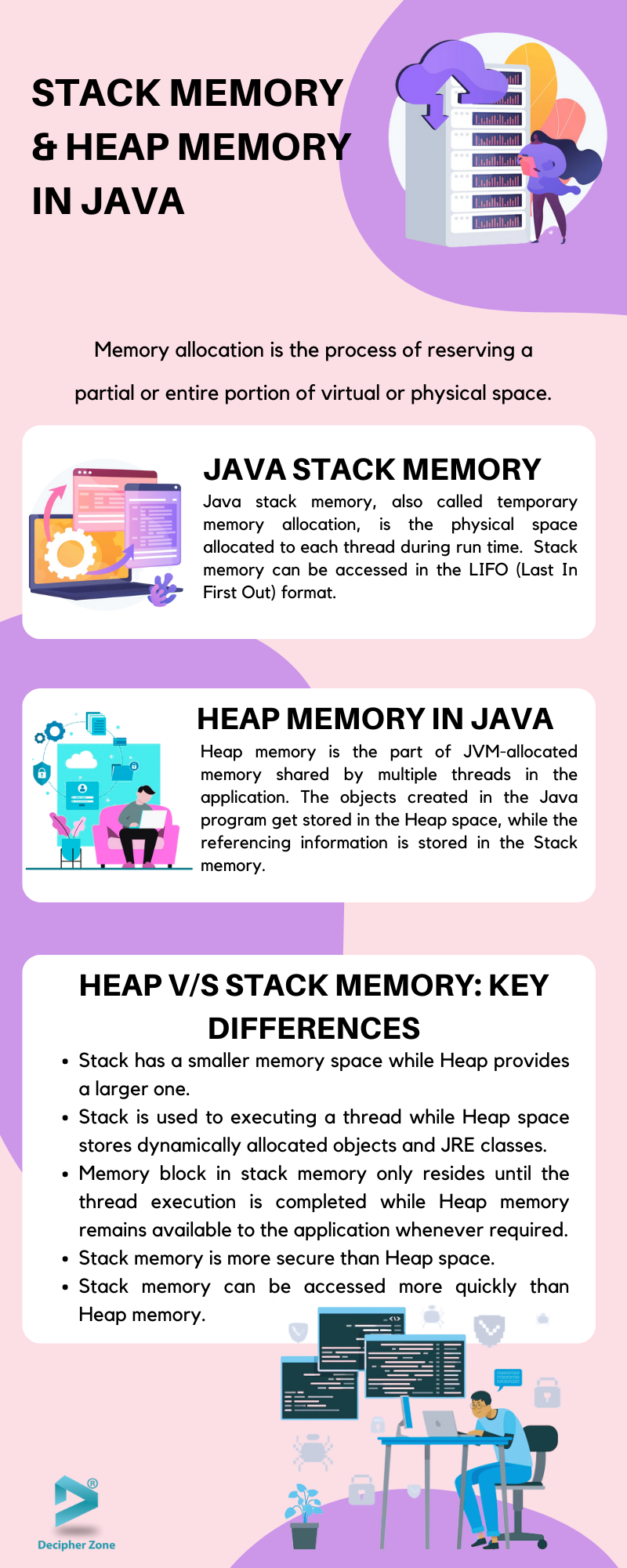Stack Memory vs Heap Memory in Java. We all know Java doesn’t require programmers’ intervention to manage the memory. Its Garbage Collector frees up the memory when not used. So, why does a Java programmer need to understand memory management then?
Although you don’t have to worry about destroying objects, thanks to Garbage Collector, it cannot destroy some entities to clean space as they don’t allow automatic garbage collection.
Read: Top Best Tools For Java Developers
Thus, memory management becomes crucial if a developer wants to write high-performing code that will not crash easily. Even if the code creates bottlenecks, developers will know how to debug them.
In this blog, we will cover everything you need to know about Java Memory Allocation and its types.
Memory Allocation in Java
Memory is a crucial resource for every programming language, but it is usually scarce, making it essential to thoroughly manage the memory without any leaks.
Read:Why Java is better for web development
Memory allocation is the process of reserving a partial or entire portion of virtual or physical space. This reserved virtual space is assigned to a program or process for execution through a process called memory management.
To keep memory management lean, it is partitioned in ways that need less memory and helps the application program to run faster.
Read:Java vs. JavaScript: Know The Difference
In Java, memory is allocated in Java Virtual Machine (JVM) which is broadly divided into Stack Memory and Heap memory.
Java Stack Memory: An Overview
Java stack memory, also called temporary memory allocation, is the physical space allocated to each thread during run time. It is a static memory allocation process where every primitive data value of a method, function calls, and heap memory object is stored. Stack memory can be accessed in the LIFO (Last In First Out) format.
But, what does this LIFO mean? When a method is called, it creates (pushes) a new block on the top of stack memory to hold local values and references to other method objects. And once the method ends, the block is cleared (popped) to be used in the next method.
Put simply, Stack is the area that stores temporary variables that a function creates. In stack memory, all the variables are stored, declared, and initialized at the runtime, i.e, the memory will be automatically cleared.
Read: Top 5 Best Free Java Development IDE
Stack memory allocation takes place on a contiguous memory block. The compiler determines the amount of memory that each type of variable in the program will need before allocation. A programmer doesn’t have to worry about the allocation and deallocation of Stack memory.
The size of stack memory is restricted and if the program or process consumes more memory than the stack size, it will create a stack overflow leading to the failure of the program. To avoid stack overflow, you need to write a base condition for a program’s recursive call.
Different Stack Operations: push(), pop(), isEmpty(), size(), isFull(), and top().
Pros and Cons of Java Stack
With a better understanding of Java Stack, you must also know its pros and cons.
Read: Java For Data Science: What, Why, and When
Pros of Java Stack Memory:
-
Stacks automatically expand and shrink with each new method being called and returned respectively.
-
It automatically allocates and deallocates memory to objects.
-
Stack variables exist as long as the main method is being executed.
-
It has fast memory access.
-
The stack doesn’t need synchronization and is thread-safe as every thread operates in a stack of its own.
Cons of Stack Memory in Java:
-
You need to define the stack size before execution, making it limited to that size only.
-
In case the objects created exceed the defined size, it will lead to stack overflow.
-
You cannot access methods randomly.
-
Stack falling outside the memory can cause abnormal or early termination of the program.

Heap Memory in Java
Heap memory is the part of JVM-allocated memory shared by multiple threads in the application. It is used by Java runtime for allocating memory to JRE classes and objects. It provides a pile of space for developers to allocate and deallocate, hence, is called Heap.
Read: Using Proxies with Java Web Scraping
NOTE: Heap memory has nothing to do with the heap data structure.
The objects created in the Java program get stored in the Heap space, while the referencing information is stored in the Stack memory.
Heap memory allocation is further partitioned into three categories, namely, Young Gen, Old or Tenured Gen, and Permanent Gen, that help in prioritizing the Objects to be stored in the Heap space or Garbage collection.
Read: Best Tech Stack for Web App Development
Heap memory is used by the application as long as it runs and does not follow any order like Stack. In Heap space, the memory blocks are handled dynamically as the Java Garbage Collector deletes or terminates the objects not being used. It throws java.lang.OutOfMemoryError, if the space of Heap memory gets full. Unlike Stack memory, Heap objects can be accessed from anywhere in the application as they have global access.
Pros and Cons of Java Heap
As we know what Heap Memory or Space is, let’s understand the pros and cons of using Java Heap memory.
Pros of Heap Memory in Java:
-
Heap memory is not static, hence can expand or shrink according to the program requirements.
-
It provides global access to the created objects, making them accessible from anywhere in the application.
-
Not following LIFO, FIFO, etc., Heap memory allows random access.
-
Can be used in Priority Queue.
Cons of Heap Memory in Java:
-
Heap is prone to memory leaks.
-
It has a much slower object access time as compared to stack memory, making it unavailable for other processes.
-
Heap memory uses complex memory management techniques for the allocation and deallocation of memory.
-
Heap memory requires Garbage collection to free up space as it is not done automatically.
Heap v/s Stack Memory: Key Differences
Although we now know what heap and stack memory in Java is, it’s time to do a head-to-head comparison to help you easily compare the key differences both of them have.

Conclusion
So, that was all about stack and heap space in Java. We hope you found it helpful for your upcoming projects. Concluding, JVM has two types of memory to make the application execution more efficient. All the method calls, references, and primitive type variables are stored in stack memory while all the dynamic objects get stored in the heap memory.

If you are an entrepreneur looking to develop a Java web application for your business, then get in touch with our experts who will gather your requirements and help you to hire developers who have years of experience and expertise in creating web apps best suited for your needs at an affordable cost.
So, what are you waiting for? Contact Us Now!

